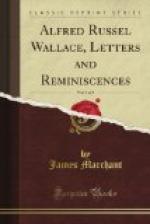As he grew from childhood into youth, Alfred Wallace’s extreme sensitiveness developed to an almost painful degree. He grew rapidly, and his unusual height made him still more shy when forced to occupy any prominent position amongst boys of his own age. During the latter part of his time at Hertford Grammar School his father was unable to pay the usual fees, and it was agreed that Alfred should act as pupil teacher in return for the lessons received. This arrangement, while acceptable on the one hand, caused him actual mental and physical pain on the other, as it increased his consciousness of the disabilities under which he laboured in contrast with most of the other boys of his own age.
At the age of 14 Wallace was taken away from school, and until something could be definitely decided about his future—as up to the present he had no particular bent in any one direction—he was sent to London to live with his brother John, who was then working for a master builder in the vicinity of Tottenham Court Road. This was in January, 1837, and it was during the following summer that he joined his other brother, William, at Barton-on-the-Clay, Bedfordshire, and began land surveying. In the meantime, while in London, he had been brought very closely into contact with the economics and ethics of Robert Owen, the well-known Socialist; and although very young in years he was so deeply impressed with the reasonableness and practical outcome of these theories that, though considerably modified as time went on, they formed the foundation for his own writings on Socialism and allied subjects in after years.
As one of our aims in this section is to suggest an outline of the contrasting influences governing the early lives of Wallace and Darwin, it is interesting to note that at the ages of 14 and 16 respectively, and immediately on leaving school, they came under the first definite mental influence which was to shape their future thought and action. Yet how totally different from Wallace’s trials as a pupil teacher was the removal of Darwin from Dr. Butler’s school at Shrewsbury because “he was doing no good” there, and his father thought it was “time he settled down to his medical study in Edinburgh,” never heeding the fact that his son had already one passion in life, apart from “shooting, dogs, and rat-catching,” which stood a very good chance of saving him from becoming the disgrace to the family that his good father feared. So that while Wallace was imbibing his first lessons in Socialism at 14 years of age, Darwin at 16 found himself merely enduring, with a feeling of disgust, Dr. Duncan’s lectures, which were “something fearful to remember,” on materia medica at eight o’clock on a winter’s morning, and, worse still, Dr. Munro’s lectures on human anatomy, which were “as dull as he was himself.” Yet he always deeply regretted not having been urged to practise dissection, because of the invaluable aid it would have been to him as a naturalist.




